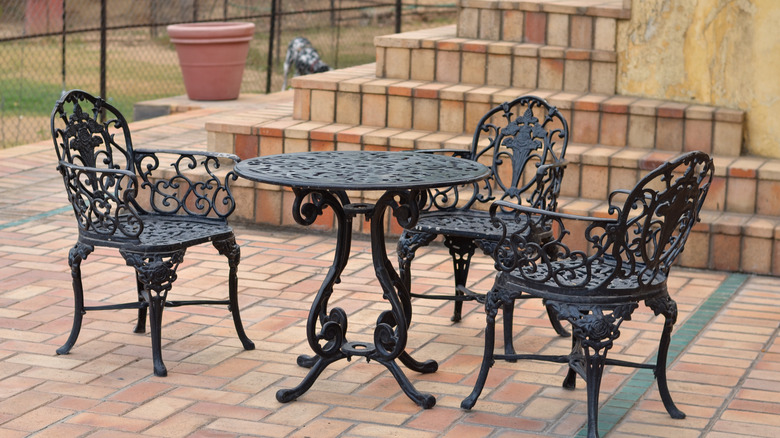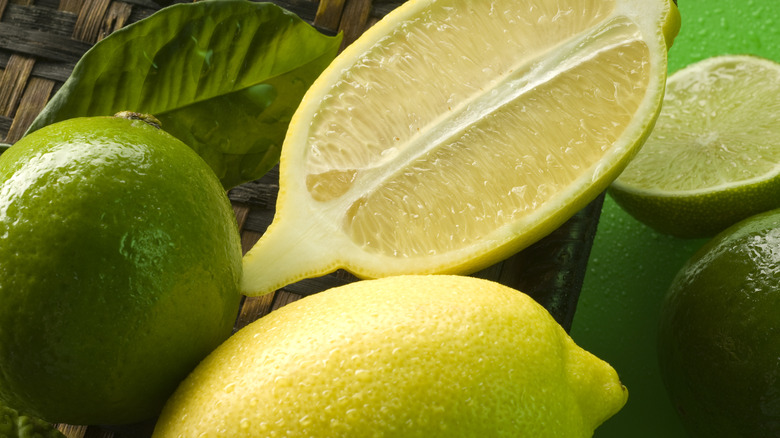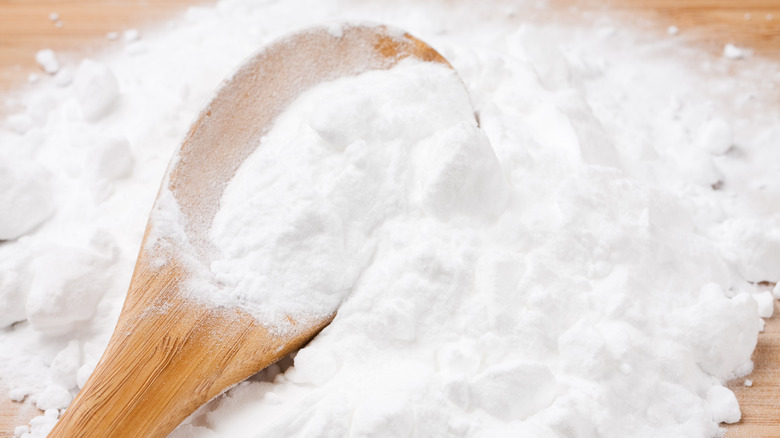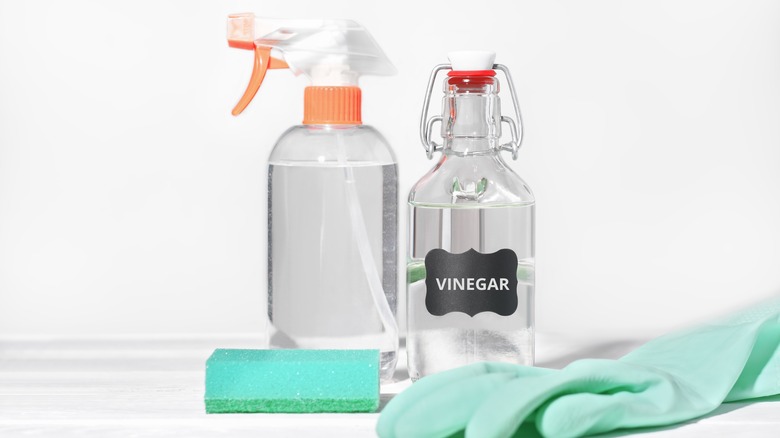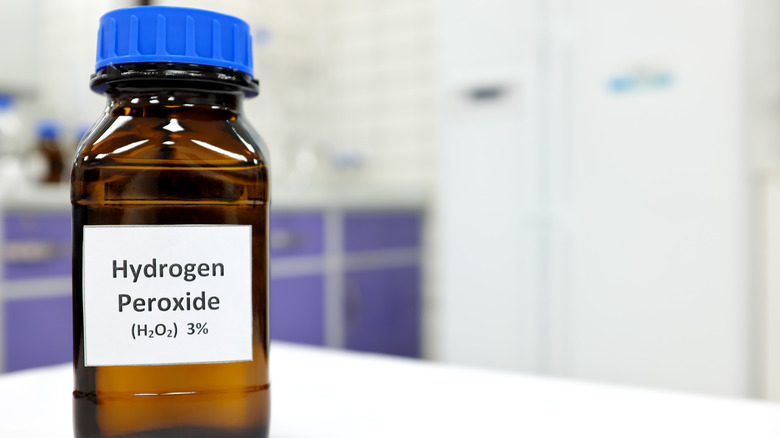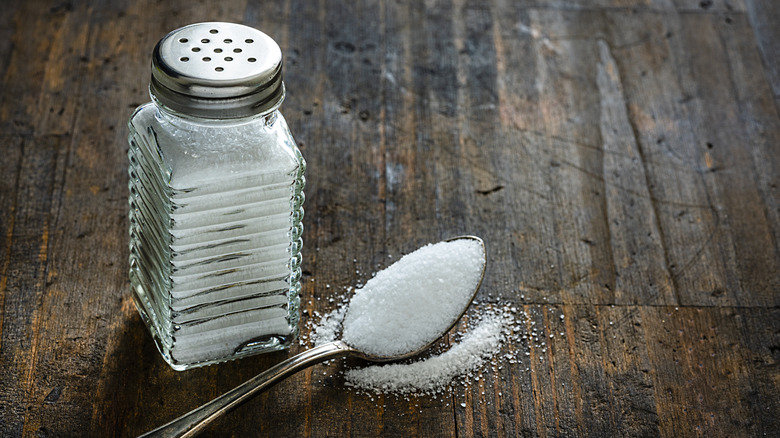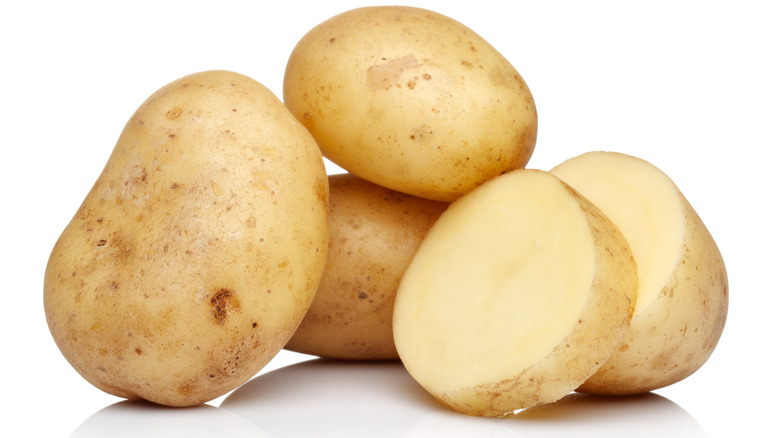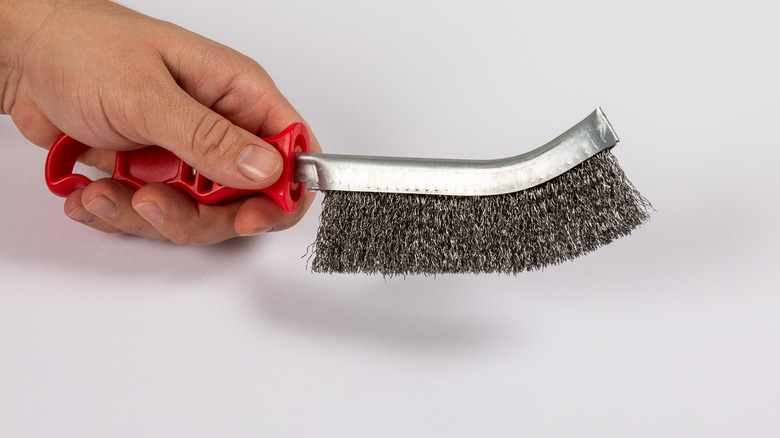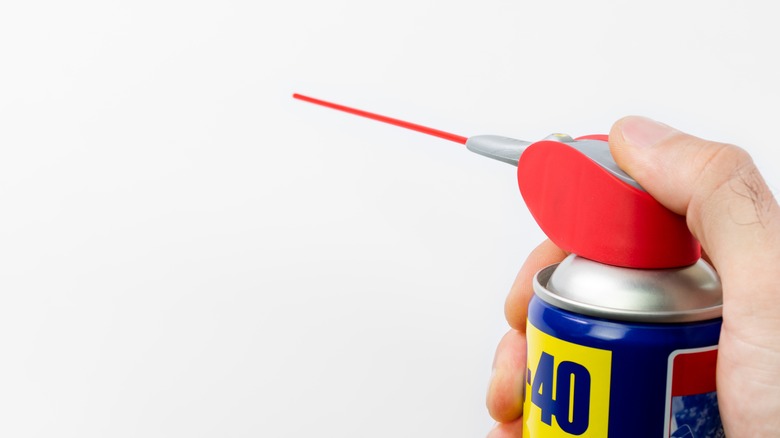Make Rusty Furniture New Again With These Simple Hacks
When the warm weather of springtime replaces the cold winds of winter, many people begin to spruce up their patio furniture in preparation for outdoor dining, relaxing, and entertaining. Unfortunately, metal furniture that has been exposed to outdoor conditions may show signs of rust, requiring special cleaning techniques. According to Cornell University, rust is the common name for iron oxide (Fe₂O₃). It forms when iron or metals that contain iron come into contact with oxygen and water or moisture. Rust not only causes unsightly stains on your outdoor furniture, but it's also a type of corrosion that causes the metal to deteriorate over time.
Based on the nature of rust, there are numerous remedies available. Some of them employ combinations of natural products in homemade recipes that won't harm your family or the environment. These hacks provide safe and inexpensive solutions to the rust problem. Read on to learn about rust-removal techniques and processes that will have you reaching into your pantry for household staples like lemon juice, white vinegar, baking soda, and scouring pads.
Citric acid, lemon juice, and lime juice dissolve rust from metal furniture
Citric acid is known to dissolve rust, and you can buy it in health food stores as well as some pharmacies and groceries. But the downside is that it is strong enough to dissolve the paint on your metal furniture, along with the rust. That's why the experts at the University of Georgia Extension recommend natural citrus juices to remove the discoloration and stains that appear on rusting metal surfaces. According to PubMed, lemon juice contains 1.44 grams of citric acid per ounce, and lime juice contains 1.38 grams per ounce. These concentrations of citric acid are enough to remove rust without stripping the underlying paint. As an added bonus, lemon juice acts as a mild degreaser and bleach to restore a clean appearance to your outdoor furniture.
To use lemon or lime juice as a rust remover, you'll need to combine it with a mildly abrasive substance like salt, baking soda, or powdered Borax. First, sprinkle the abrasive granules onto the rusted metal and then add the lemon or lime juice. Alternatively, you can pre-mix the citrus juice with the abrasive substance to make a thick paste and spread the paste onto the metal. Let the mixture sit on the metal for two hours and follow up by scrubbing with a brush or with the peel of a lemon or lime. Finally, wash off the mixture with clear water and dry the furniture with a dry cloth.
Grab that box of baking soda from the pantry to remove rust from metal furniture
Baking soda is pure sodium bicarbonate (NaHCO₃). It's a crystalline salt derived from nahcolite, a mineral found in natural mineral springs. With a pH of 8, baking soda is designated as an alkaline or basic substance. That means it's the opposite of acidic. Baking soda helps to reverse the oxidation process that causes rust. Essentially, the rust dissolves when it comes in contact with the alkaline solution of baking soda mixed with water. Additionally, baking soda features a gritty texture that makes it an effective option for scrubbing rusty surfaces. The physical abrasion helps to loosen the rust particles from the metal.
To remove rust from your metal furniture, you'll need to make a thick paste of baking soda and water. Apply the paste to the rusted area and let it sit for 20 minutes. Then, scrub it off with a mildly abrasive scrubbing pad. For heavy rust, you might substitute hydrogen peroxide for the water when you make the paste. If the rust is not completely removed, you may need to repeat the process.
White vinegar banishes rust from your outdoor furniture
To clean rust from your backyard furniture, white vinegar offers the power of acetic acid. In fact, the product that's readily available on grocery store shelves contains 4-to-6 percent acetic acid dissolved in water. Rust is the result of iron or metals that contain iron reacting with oxygen and water or moisture. But the acetic acid in vinegar causes rust to neutralize and dissolve into a mixture of salt and water that can be washed away with ease.
You can use a scrubbing pad saturated with white vinegar to remove rust from outdoor furniture. Alternatively, you might apply the vinegar from a spray bottle and follow up by scrubbing with a stiff brush or scouring pad. For heavy rust build-up, it's a good idea to loosen the flaky, brown substance with a wire brush or scraper before applying the vinegar. After scrubbing with white vinegar, you can finish the job by wiping your furniture with a microfiber cloth soaked in a solution of 1 cup of baking soda dissolved in 1 gallon of water. The baking soda will neutralize the acetic acid from the vinegar. Then, do a final rinse with clear water and dry the furniture with a towel.
Reach for the hydrogen peroxide to dissolve rust from your patio furniture
According to the Cleveland Clinic, hydrogen peroxide is a chemical compound made up of water (H₂O) with one extra oxygen molecule (H₂O₂). The type of hydrogen peroxide that you might use for dissolving rust from patio furniture is the medical-grade type composed of 3 percent peroxide and 97 percent water. You can find it in most pharmacies and grocery stores. Household hydrogen peroxide is packaged and stored in a brown bottle to prevent the decomposition that occurs in the presence of sunlight.
You can use household hydrogen peroxide straight from the bottle to remove rust from metal furniture. Simply pour it on, and it will begin a bubbling action that loosens the rust particles. When the bubbling stops, it's time to scrub the surface with steel wool or a scraper. Then, rinse with clear water and dry your metal furniture with a towel. Be sure to wear protective gloves when working with hydrogen peroxide, and never mix it with vinegar.
As an alternative method, you can tackle rusty furniture with a heavy paste made from cream of tartar and a small amount of hydrogen peroxide. Smear the paste onto the rusted areas and allow it to sit for 30 minutes. Then, buff the surface with a damp sponge and wipe it dry with a paper towel.
Salt acts as an abrasive that speeds up the rust removal process
Regular table salt consists of 97-to-99 percent sodium chloride (NaCl). Its granulated texture makes salt an ideally abrasive compound for scrubbing rust off your patio furniture. When salt is added to vinegar, it increases the strength of the acetic acid, allowing vinegar to cut through rust at a faster rate. For 1 gallon of white vinegar, add 1 cup of salt. Apply the mixture to the rusted metal and allow it to sit for at least 30 minutes. Then, scrub with a brush or scouring pad. Next, neutralize the acid with a rinse made from 1 cup of baking soda dissolved in 1 gallon of water. Be aware that while vinegar and salt will not harm iron and steel, it can eat through aluminum.
Similar to the salt-and-vinegar combo, salt works well with lemon juice to remove rust. First, make a paste from equal parts of lemon juice and salt. Then, dip a mildly abrasive scouring pad into the paste, and spread it on the rusty furniture surfaces, using a circular motion. Completely cover the rust and allow the paste to sit on the surface for at least 30 minutes or up to 2 hours. Next, scrub the rusted surfaces with the scouring pad or a stiff brush. Rinse with clear water, and dry your furniture with towels. Do not allow the lemon juice to sit on the furniture overnight, as the water content in the juice will trigger new rust.
Use a raw potato to remove rust from metal surfaces
When you see rust on your outdoor furniture, do you think of reaching into the pantry for a raw potato? Probably not. But the oxalic acid in potatoes works as a rust eliminator. Core Chem Inc. explains that when oxalic acid comes in contact with rust, it causes a double displacement reaction that turns the iron oxide known as rust into an iron oxalate. This is a water-soluble salt that washes away easily. In its chemical form, oxalic acid is poisonous and harmful, making it too dangerous to use as a household cleaning product for rust removal. Fortunately, the reduced strength of the oxalic acid in a raw potato is safe and non-toxic, making it a cheap and commonly available rust fighter.
To use this method for rust removal on your lawn furniture, you'll need to start with either baking soda or table salt to act as a natural abrasive. Pour the granules on the rusted metal and then rub the area with the inner surface of a raw potato. To get the most oxalic acid from the potato, cut it lengthwise, revealing a large surface of the interior flesh. Use the potato as you would a scrubbing pad, rubbing it into the rusty area. Follow up by rinsing the furniture with clear water and allowing it to dry.
Clean rust off your outdoor furniture with abrasive tools and a bit of elbow grease
While natural cleaning solutions provide viable hacks for removing rust from patio furniture, there are a number of options that wear away the rust by the simple physical act of abrasion. DIYers use tools like wire brushes, steel wool pads, electric sanders, Dremel rotary tools, and even aluminum foil to attack rust on outdoor furniture.
Heavy rust on wrought iron furniture may require scrubbing with a wire brush or applying an electric sander with medium-grit silicon carbide paper. After the top layer of rust has been removed with coarse-textured tools, you can reach the hard-to-remove rust with fine sandpaper or steel wool. A Dremel rotary tool with an aluminum oxide grinding stone offers an additional option for removing rust from patio furniture to reveal the bare metal and prepare the surface for painting. Linked items are available at Lowe's. For light rust, you can use aluminum foil, an inexpensive kitchen staple. Crumple a piece of foil into a ball and dip it in salt water. Then, use it to scrub the rust off your metal furniture.
Spraying your patio furniture with WD-40 will remove rust and prevent the problem of future corrosion
Many DIYers keep WD-40 lubricant spray around the house for multiple purposes, including squeaky hinges and stubborn metal bolts that get stuck. But did you know that WD-40 revives rusty patio furniture? According to the WD-40 Company, the lubricant was first used in the aerospace industry to prevent rust on the metal parts of spacecraft. You can put it to work in your own backyard to remove rust from your outdoor furniture and prevent future corrosion.
With WD-40, the rust removal process is easy. Simply spray it on the rusted metal surface and let it sit for 10 minutes. With its lubricating capacity, WD-40 will loosen the tight bond between the rust and the metal. Then, scrub the area with an abrasive tool like a stiff brush, scouring pad, sandpaper, or steel wool. If some rust remains after the first try, you can repeat the process of spraying and scrubbing at 10-minute intervals until the rust is completely removed. One of the advantages of cleaning your patio furniture with WD-40 is that it prevents rusting in the future. Once you have the metal surfaces clean, give them a once-over with the spray lubricant and wipe off the excess. The WD-40 will leave behind a protective coating to ward off new rust formation.
